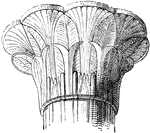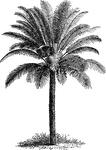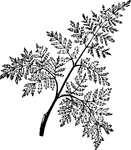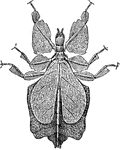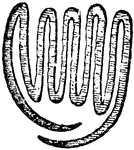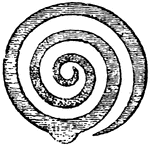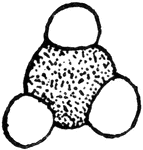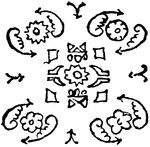
Herati Design
Also known as the fish, twin fish and Feraghan designs. Better known as the Herati. It originated in…

Tree Design
Sometimes called the tree of life. Always associated with religious belief. It symbolizes Divine power…
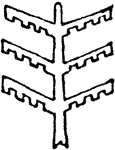
Tree Design
Sometimes called the tree of life. Always associated with religious belief. It symbolizes Divine power…
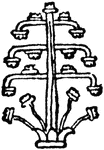
Tree Design
Sometimes called the tree of life. Always associated with religious belief. It symbolizes Divine power…
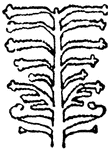
Tree Design
Sometimes called the tree of life. Always associated with religious belief. It symbolizes Divine power…
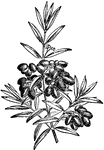
Olive
A genus of evergreen trees and shrubs found in the warmer regions of temperate climates. They attain…
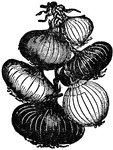
Onion
An edible bulb, produced by a biennial herb of the lily family. The plant has tubulated leaves, a pithy…
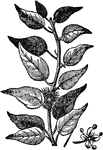
Osage Orange
A tree of the nettle family, so named from the Osage Mountains of Arkansas, where it is native, but…

Papaw
A tree native to tropical America, allied to the passion flower family, and now extensively cultivated…
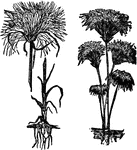
Papyrus
A genus of rushlike plants of the sedge family, growing in marshy places from root-stalks. The stem…

Petunia
A genus of plants of the nightshade family, which are native to the warmer parts of America. The leaves…
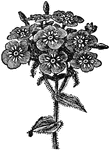
Phlox
A genus of plants with opposite leaves and beautiful flowers. There are many different species, mostly…
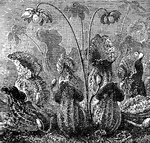
Pitcher Plants
A group of plants remarkable for having leaves or petioles formed like pitchers, and in which more or…

Rhododendeon
An extensive genus of shrubs of the heath family. The leaves are usually alternate and evergreen in…

Rose
The common name of plants of the genus rosa. They have prickly stems and unequally pinnate leaves. About…
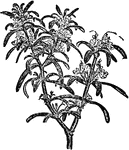
Rosemary
An evergreen shrub of the mint family, which is native to southern Europe and western Asia. It is from…
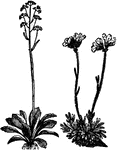
Saxifrage
An extensive genus of hardy perennial herbs, with alternate leaves and simple flower-stems. They are…

Sunflower
A genus of plants of the aster family, which have large, cordate leaves and terminal, flat, circular,…
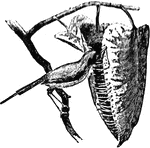
Tailorbird
A genus of birds of the warbler family, and so named from their habit of sewing leaves of cotton or…

Yucca
A genus of plants of the lily family, having woody stems, lanceolate leaves, and a large panicle of…

Oxygen Release
This illustration shows oxygen escaping leaves when they are placed in water and then in sunlight.
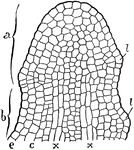
Growing Stem
This illustration shows the longitudinal section of the tip of a growing stem: e, epidermis extending…
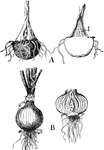
Onion
This illustration shows the shortened types of stems: A, corm of jack-in-the-pulpit. At left surface…
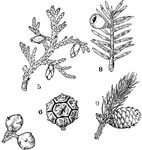
Pinales
This illustration shows some common examples of Pinales: 5, Thuja or arbor vitae. 6, Strobilus, of Chamaecyparis…
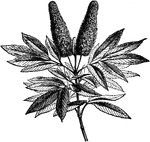
Cunonia
A small genus of plants. They are small trees or shrubs with compound leaves and dense racemes of small…

Quatrefoil
In architecture, a piercing or panel divided by cusps or foliations into four leaves, or more correctly…

Darlingtonia
A remarkable genus of American pitcher plants. The leaves are trumpet shaped up to length of 3 feet.

Thorn Apple
A genus of plants, with angular toothed leaves, large funnel shaped flowers, and a prickly, globular,…
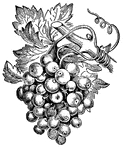
Vine
A well-known climbing shrub, which consists of climbing plants with woody stems, simple or compound…
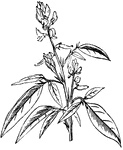
Telegraph Plant
A complicated plant with trifoliate leaves, small flowers, and flat, deeply lobed and jointed pods.

Composite Order
A mised order, combining the volutes of the Ionic order with the leaves of the Corinthian order.

Venus Fly Trap
A plant with a rosette of root leaves, from which rises a naked scape bearing a corymb of rather large…

Door Palm
A type of palm having repeatedly branched stem, each branch terminating in a tuft of large fan shaped…
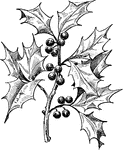
Holly
"A species of the genus Ilex, which contains about 175 species distributed throughout the world. They…
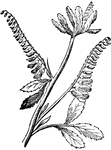
Melilot
"A genus of clover-like plants of the natural order Leguminosae, with ternate leaves, differing from…

Papaw Tree
"A South American tree of the natural order Papayaceae of which order about 30 species are known which…
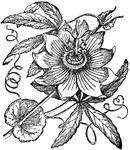
Passionflower
"A genus of plants almost exclusively native to the warm parts of America, and belonging to the natural…

Bud
"Transverse section of a bud, in which the leaves are arranged in an accumbent manner." — Encyclopedia…

Bud
"Transverse section of a bud, in which the leaves are arranged in an equitant manner." — Encyclopedia…

Bud
"Transverse section of a bud, showing two leaves folded in an obvolute manner. Each is conduplicate,…
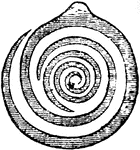
Bud
"Transverse section of a bud, showing two leaves arranged in a supervolute manner." — Encyclopedia…

Rose
"Proliferous or monstrous Rose, showing the prolongation of the axis beyond the flower. C, calyx transformed…

Purple Foxglove
A biennial herb native to Europe. Its leaves and flowers are poisonous to humans and some animals.
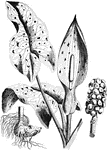
Cuckoo Pint
A common plant of the north temperate Europe. It has purple spotted leaves and can force people to have…
